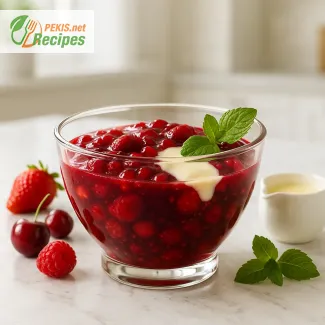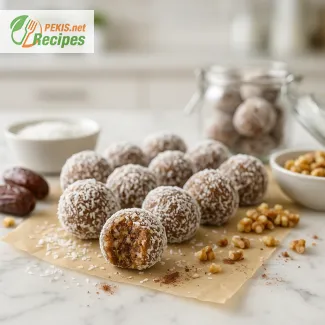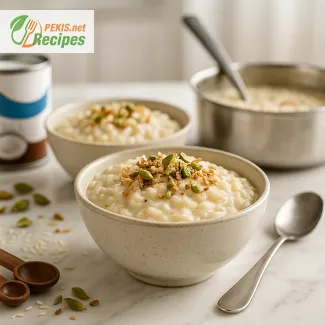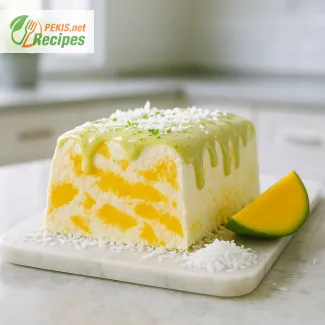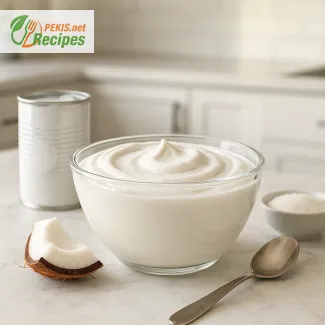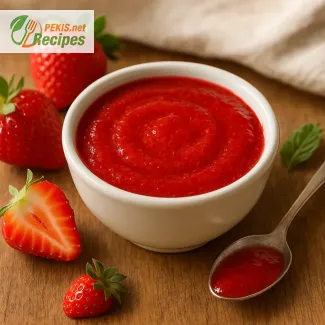
Discover the Natural Sweetness of Homemade Strawberry Puree
A vibrant fruit sauce perfect for desserts, drinks, and more
Few ingredients embody the pure essence of summer quite like strawberries. With their bright red hue, fragrant aroma, and naturally sweet flavor, strawberries are a beloved fruit across the globe. When transformed into a smooth and luscious strawberry puree, they become even more versatile—ready to enhance a wide variety of dishes, from decadent desserts to refreshing drinks, wholesome breakfasts, and even savory creations.
This easy strawberry puree recipe, made with either fresh or frozen berries and no added sugar, is a kitchen staple you’ll turn to time and again. Whether you're spooning it over pancakes, swirling it into yogurt, or folding it into whipped cream, this simple preparation brings out the very best of what strawberries have to offer—naturally vibrant flavor with none of the unnecessary additives.
There’s something incredibly satisfying about making your own fruit puree from scratch. You get to control the quality of ingredients, adjust the texture to your liking, and enjoy a fresher, more intense flavor than store-bought alternatives. What’s more, the process is incredibly quick and easy, requiring only a few minutes of active time and minimal equipment.
Why strawberry puree is a kitchen essential
Strawberry puree isn't just a fancy ingredient used in professional kitchens—it's a multifunctional fruit sauce that anyone can make at home. Its uses span beyond the obvious dessert applications. Think homemade smoothies with a deeper berry note, cocktails with a splash of natural color, or even vinaigrettes infused with a sweet-tart finish.
The beauty of strawberry puree lies in its simplicity and adaptability. Use it as-is for a pure and fruity experience, or combine it with other ingredients like vanilla, balsamic vinegar, lemon juice, or mint to create nuanced sauces that suit a variety of dishes. The puree can be made chunky or silky-smooth, depending on your desired outcome. You can strain it for a refined finish or leave the seeds in for a more rustic texture.
Another major advantage? It’s a fantastic way to make use of overripe strawberries that may not be ideal for eating fresh but still pack plenty of flavor. Likewise, frozen strawberries work just as well, making this recipe available year-round, even when fresh strawberries are out of season.
A healthy and natural alternative to sugary sauces
One of the most appealing aspects of this homemade strawberry puree is that it contains no added sugar. Unlike many commercial versions that are loaded with syrups and preservatives, this puree lets the natural sweetness of the strawberries shine through. It’s a wonderful choice for health-conscious individuals, parents looking to make wholesome baby food, or anyone wanting a clean, fruit-forward flavor.
That said, if you prefer a sweeter taste, you can always add a drizzle of honey, maple syrup, or a pinch of your favorite natural sweetener. But in most cases, especially when using ripe, in-season strawberries, no extra sugar is needed at all. The fruit does all the work.
How to use strawberry puree in everyday cooking
This simple strawberry puree opens the door to countless culinary applications. Use it as a:
- Topping for pancakes, waffles, and French toast
- Swirl for cheesecakes and panna cottas
- Base for smoothies, milkshakes, and ice cream
- Mix-in for yogurt, oatmeal, or overnight oats
- Filling for cakes, cupcakes, or layered desserts
- Component in cocktails, mocktails, and lemonade
- Drizzle over pavlovas, brownies, or scones
- Sauce for roast pork or grilled chicken with a fruity twist
Whether you're cooking for yourself, your family, or hosting a brunch with friends, having a batch of strawberry puree in the fridge or freezer means you're always prepared to elevate your meals with a splash of vibrant berry flavor.
Fresh vs. frozen strawberries: what's better?
When it comes to making strawberry puree, both fresh and frozen strawberries can be excellent choices. If strawberries are in season and at their peak, fresh berries will give you the fullest flavor and the brightest color. Look for plump, fragrant strawberries with a deep red hue and minimal white at the stem.
Frozen strawberries, on the other hand, are often picked and frozen at their ripest, locking in their flavor and nutrients. They're also a convenient option that allows you to make this puree any time of year. Just make sure to thaw them slightly before blending to ensure a smooth result.
Both options can produce outstanding puree, so it often comes down to what’s available and your personal preferences.
Tips for storing and freezing
Once prepared, strawberry puree can be stored in an airtight container in the refrigerator for up to 5 days. It also freezes beautifully. Simply pour the puree into an ice cube tray or silicone mold, freeze, then transfer the cubes to a zip-top bag. This way, you can pop out individual portions whenever needed—perfect for adding to smoothies or sauces on the fly.
You can also preserve the puree in small glass jars for gifting or future use. A touch of lemon juice helps maintain color and freshness, especially if you’re planning to store it longer or use it in drinks.
This easy no-sugar strawberry puree is a delicious, healthy, and beautiful addition to your kitchen repertoire. With just one ingredient and a few minutes of prep, you can transform everyday dishes into something truly special. Whether you're blending it into a breakfast bowl or topping a fancy dessert, this versatile puree is sure to become a go-to favorite.
1. Clean the strawberries:
Rinse the strawberries thoroughly under cold running water. Remove the green stems (hulls) using a paring knife or a strawberry huller.
2. Prepare the strawberries for cooking:
Cut large strawberries in half or quarters to ensure even cooking. If using frozen strawberries, let them thaw for 10–15 minutes before use.
3. Cook the strawberries (optional for thicker consistency):
Place the strawberries in a saucepan over medium heat. Cook for about 8–10 minutes until the fruit breaks down and releases its juices. Stir occasionally to prevent sticking. You can skip this step if you want a raw puree with a fresher taste.
4. Add lemon juice:
Once the strawberries are softened (or fresh if uncooked), add the lemon juice to brighten the flavor. Stir well to combine.
5. Blend the mixture:
Transfer the strawberries (with or without the cooking liquid) into a blender or food processor. Blend until completely smooth. If you prefer a seedless puree, pour the mixture through a fine mesh sieve into a bowl, using a spoon or spatula to press the liquid through.
6. Cool and store:
Allow the puree to cool completely. Transfer to a clean airtight container. Store in the refrigerator for up to 5 days or freeze in portions for longer use.
Enhancing the Flavor and Versatility of Homemade Strawberry Puree
Smart ways to upgrade a simple classic with texture, taste, and nutrition in mind
While the basic strawberry puree recipe is already beloved for its simplicity and naturally sweet flavor, there are numerous ways to elevate its character, whether for gourmet presentation, nutritional enrichment, or a more personalized experience. A single adjustment—be it a change in texture, a new spice, or a creative pairing—can significantly shift the flavor profile and enhance its culinary value. Let’s explore how to refine and enrich this classic preparation.
Adding depth with complementary ingredients
One of the easiest ways to enhance strawberry puree is by introducing aromatic and flavorful companions. These additions can help balance the sweetness, add complexity, or infuse an unexpected twist.
Citrus zest or juice
A small amount of lemon or orange zest can brighten the overall flavor. While lemon juice is already a popular option, orange juice brings a subtle floral sweetness that pairs wonderfully with strawberries. Grapefruit zest can also add a sophisticated bitterness.
Vanilla and spices
Adding a few drops of vanilla extract or half a scraped vanilla pod transforms the puree into a more dessert-forward component, ideal for pastries or panna cotta. For warmth, try a pinch of cinnamon or cardamom, especially if serving in colder months. These spices bring out the jammy notes of the fruit and are perfect for pairing with baked goods.
Herbs and floral accents
Fresh mint or basil leaves can be blended into the puree or used as a garnish. These herbs contribute a refreshing dimension and pair especially well with cocktails or fruit salads. If you want a more delicate, aromatic profile, a dash of rosewater or elderflower syrup can be added in minimal amounts—these florals blend well without overpowering the strawberries.
Textural variations for different uses
The consistency of your puree can drastically change the experience. A thicker version is more spoonable and great for tarts or cake fillings, while a thinner one works better in drinks or sauces.
- For a chunky texture, mash strawberries by hand with a fork or potato masher instead of using a blender.
- For a glossier, gel-like finish, you can reduce the blended puree over low heat, allowing it to thicken naturally. This method also intensifies the flavor.
- If you're looking for a velvety, seedless result, strain the puree through a fine sieve or cheesecloth, removing the pulp for an ultra-smooth sauce.
Why homemade beats store-bought every time
Making strawberry puree from scratch gives you full control over the ingredients, texture, and freshness. Unlike many commercial versions, which often contain high-fructose corn syrup, artificial colorings, and preservatives, a homemade puree is pure fruit—simple, honest, and much more flavorful.
Additionally, you avoid excessive sugars and can adjust sweetness to your taste or dietary preferences. The fresh, natural flavor of homemade strawberry puree is notably more vibrant and nuanced, which is essential when you're using it as a key flavor element in a dish.
Common mistakes to avoid
Even with such a simple recipe, there are pitfalls that can diminish the final result. Here are the most common missteps:
Using underripe or overripe berries
Underripe strawberries will yield a bland, sour puree, while overripe ones can be mushy and lack brightness. Aim for ripe, firm berries with a strong aroma and rich red color.
Over-blending
Blending the puree for too long can incorporate too much air, resulting in a foamy texture. Use short pulses until smooth, or stop while it still has a slightly pulpy body if desired.
Not adjusting for sweetness
While this recipe intentionally avoids added sugar, different strawberries vary in natural sweetness. Taste your fruit first—if it's too tart, you can balance it with a touch of maple syrup or agave without compromising the “no sugar added” goal.
Healthy alternatives and nutrition-focused adaptations
Strawberry puree is already a low-calorie, nutrient-rich base, but it can be easily adapted to support specific dietary needs.
Sweeteners
If a sweeter profile is preferred, opt for natural alternatives like stevia, erythritol, or monk fruit extract instead of refined sugar. These are suitable for diabetics and people watching their caloric intake.
Protein boost
Blend in plain Greek yogurt or silken tofu for a thicker, protein-rich puree. This is a fantastic base for smoothie bowls or a quick breakfast option.
Add fiber
A tablespoon of chia seeds stirred into the puree turns it into a spreadable jam once it sets. This variation adds fiber and omega-3s, making it ideal for toast or oatmeal.
Creative serving ideas for more impact
Upgrading the puree doesn’t stop at the preparation—it also shines in how it’s used. For instance:
- Layer it into parfaits with granola and whipped coconut cream
- Drizzle over baked brie and serve with crackers for an upscale appetizer
- Mix into vinaigrettes with balsamic and olive oil for a salad dressing with depth
- Freeze into popsicles for kids or blend into adult-friendly frozen cocktails
This basic recipe is merely the beginning of what you can do with strawberry puree. By experimenting with textures, flavors, and applications, you can easily tailor it to your tastes and occasions. It’s a testament to how something simple can become exceptional with a bit of creativity and intention. Whether you’re topping a cheesecake, stirring it into yogurt, or serving it at a brunch table, these enhancements will make your version stand out every time.
This recipe is naturally free from common allergens such as dairy, eggs, nuts, soy, and wheat.
It is also gluten-free.
Substitution tips for allergen safety:
No substitutions are necessary unless adding ingredients like sweeteners or toppings. Always check labels if combining with other foods.
- Vitamin C: 42 mg – boosts immune system, supports collagen production
- Folate (B9): 18 mcg – essential for DNA synthesis and cell function
- Potassium: 150 mg – supports heart health and blood pressure regulation
- Magnesium: 12 mg – helps with muscle and nerve function
- Manganese: 0.3 mg – important for metabolism and bone health
- Anthocyanins: 50 mg – fight oxidative stress and inflammation
- Ellagic acid: 4 mg – supports cellular health, anti-carcinogenic properties
- Vitamin C (as antioxidant): 42 mg – protects against free radicals and promotes skin health
